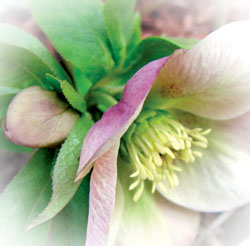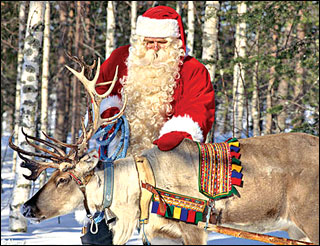Seasonal fare
The star of
Bethlehem
One of the most significant symbols in the Nativity story, (the birth
of Jesus), is the Star of Bethlehem, also known as the Star of Christmas
by many. What really was this bright, unusual star that, according to
the Gospel of Matthew, the Magi or the Three Wise Men saw and followed
to see the King who was born?
"Where is He who has been born King of the Jews? For we have seen His
star in the East and have come to worship Him", the Wise Men are
recorded to have told King Herod, the ruler at that time.
This powerful and enigmatic, symbol of Christianity. second perhaps
only to the Cross of the Crucifixion, is traditionally linked to the
Star Prophecy in the Book of Numbers in the Holy Bible:
I see Him, but not now;
I behold Him, but not near;
A Star shall come out of Jacob;
A Sceptre shall rise out of Israel,
And batter the brow of Moab,
And destroy all the sons of Tumult.
However, today it has become a controversial topic with many scholars
questioning the historical accuracy of the story and arguing that the
star was a fiction created by the author of the Gospel of Matthew.
Many theories have been put forward about the true origin of the Star
of Bethlehem, which has baffled astronomers, historians, and theologians
for the past two millennia or more.
But despite all this, the Star of Bethlehem continues to play an
important role in the story of the Nativity of the Christ child and is
almost on a par with the birth itself.No matter what is said by the
scholars about the star of Bethlehem, the conclusion is that it cannot
be naturally explained by scientists. As Christmas, which is the
commemoration of the Nativity of the Christ child, is all about
miracles, perhaps the star the magi referred to was only a temporary and
supernatural light that shone, especially to mark the birth of Jesus
Christ.
Special blossoms
Come Christmas you will notice very striking, star like flowers (both
artificial and natural) being used as decoration, not only in shops, but
also in many houses. Why are these blossoms in red so popular during the
season?
Commonly known as poinsettias (Euphorbia pulcherrima ) this species
of flowering plant, indigenous to Mexico and Guatemala, came to be
associated with the season way back in the 16th century. It is named
after Joel Roberts Poinsett, the first United States Minister to Mexico
who introduced the plant into the US in 1828.According to a Mexican
legend , a young girl who was too poor to provide a gift for the
celebration of Jesus' birthday was inspired by an angel to gather weeds
from the roadside and place them in front of the church altar.Then
crimson "blossoms" had sprouted from the weeds and become beautiful
poinsettias.

From the 17th century onwards, Franciscan friars in Mexico included
the plants in their Christmas celebrations.Then across North America,
poinsettias became typical Christmas decorations in homes, churches,
offices and elsewhere, and were available in large numbers in the
market. In the United States, December 12 is National Poinsettia Day.
In Nahuatl, the language of the Aztecs, the plant is called
Cuetlaxochitl meaning "skin flower."
The Aztecs used the plant to produce red dye and as an antipyretic
medication.Today it is known in Mexico and Guatemala as "Noche Buena" or
Christmas' Eve.
In Spain it is known as "Flor de Pascua" or Easter Flower in English.
In both Chile and Peru, the plant became known as "Crown of the Andes.
Another plant associated with the season is the English plant, the
Helleborus niger or "Christmas Rose", sometimes known as the "Snow Rose"
or "Winter Rose," it is indeed a true Christmas flower.since it blooms
during the depths of winter in the mountains of Central Europe.
The Christmas Rose produces flowers from late Fall until early
Spring. These evergreen perennials grow to be approximately 15 inches
tall and have shiny, dark green leaves of a leathery texture. Each
flower stalk bears a single two inch to four inch white bloom (often
tinged with pink).
By tradition, the Christmas Rose (whose roots are poisonous) should
be planted by the door in order that it might welcome Jesus Christ into
the home.
Like with the above mentioned poinsettias, there is a legend
associated with the Christmas Rose too. And, it is very similar to the
legend surrounding the poinsettias.
The legend of the Christmas Rose is a charming tale of a little
shepherd girl named Madelon.
As Madelon tended to her sheep one cold and wintry night, Wise Men
and shepherds passed by Madelon's snow-covered field bearing gifts for
the Christ Child.
Following them, Madelon saw the Magi present gold, myrrh and
frankincense to the baby...even the humble shepherds had brought fruits,
honey and doves to give to the babe...but Madelon had nothing, not even
a simple flower for the Newborn King.
Standing outside the stable where Jesus had been born, poor Madelon
wept, wishing that she had a gift she could carry to the infant.
An angel who was watching, taking pity on Madelon, caused the snow at
the feet of the small girl's feet to vanish, thus revealing a most
beautiful white flower, whose petals were tipped with pink, formed by
the angel from the tears which had fallen from the eyes of the little
shepherdess. Overjoyed, Madelon presented her gift at the manger of the
baby Jesus...her gift of the Christmas Rose.
Santa claus is a legend
The jolly old man with the snowy white beard and twinkling eyes who
visits good children at Christmas to leave gifts for them most often
under the tree or in the stockings or pillow cases they hang up, is a
legengary figure that is loved by all, especially the little ones... Who
actually is Santa Claus? There are many legends about the origin of this
famous character who has nothing to do with the religious event as such.

It is believed by many that the character came into being following
the kind acts shown to the poor by a Bishop who lived in the fourth
century.
Santa Claus, also known as Saint Nicholas, Father Christmas, Kris
Kringle or simply "Santa", was originally portrayed wearing bishop's
robes. But , today the image of Santa Claus is generally depicted as a
plump, jolly, white-bearded man wearing a red coat with white collar and
cuffs, white-cuffed red trousers, and black leather belt and boots. One
legend associated with Santa says that he lives in the far north, in a
land of perpetual snow. The American version of Santa Claus says that he
lives at his house on the North Pole, while Father Christmas is often
said to reside in the mountains of Korvatunturi in Lapland Province,
Finland.
There are many stories about Santa Claus living with his wife Mrs.
Claus, a countless number of magical elves, and his eight or nine flying
reindeer.It is also said that when the Christmas season draws near Santa
makes a list of children throughout the world, categorising them
according to their behaviour. So, the popular song goes..
You better not shout
you better not pout
you better not cry
I 'm telling you why
Santa Claus is coming to town
Well, he's making a list and checking it twice so that he could
deliver presents to all of the good boys and girls in the world. He is
said to accomplish this feat with the aid of the elves who make the toys
in the the workshop and the reindeer who pull his sleigh. Even though
most Christians oppose the concept of Santa Claus, today the jolly old
man has become part and parcel of Christmas and is a higly
commercialised symbol .
Customs, traditions and icons
* The custom of hanging up stockings at Christmas, which children
believe would be filled with gifts from Santa Claus, originated in
Turkey.
*Giving and receiving gifts during Christmas is the most exciting
part of the festival for children. This custom dates back to the
practice of exchanging gifts during the celebration of the winter
festival by simple farming folk.
*Decorating an evergreen fir tree or pine tree is another custom
which has its origin in winter celebrations. In fact, in ancient times,
some people honoured evergreen trees saying they reminded them that
Christ was the source of Eternal Life.
*Holly sprigs are associated with Christmas very closely. The colours
of Christmas - red and green, are represented in holly. The plant
belongs to the flex family and is found in most places. The thorny
leaves symbolise His crown of thorns, the red berries, His blood and the
evergreen nature of the plant - Life Eternal.
*During the early Celtic period, it was a custom to decorate homes
with holly. Even today holly is used in many parts of the world as
decor, especially in the form of door wreaths during the festive season.
Many superstitions surround the holly.
*It was about 300 years after the birth of Jesus Christ that Pope
Julius I and other Roman church leaders agreed on December 25 as the
official date of Christ's birth and began celebrating Christmas.
*January 6 is Epiphany, the day the 'Three Wise Men, also known as
the Magi arrived in Bethlehem bearing gifts for baby Jesus.
They are also known as the Three Kings from the Orient.
*Sometime Christmas is shortened as X'mas. Do you know that the
letter X refers to the Greek letter which is also the first letter of
Christ's name?
*It is said that it was St. Boniface who lived in the 8th century who
made the fir tree, the tree of Christmas.
*The first Christmas card was sent by Sir Henry Cole in 1843, because
he had no time to write letters at Christmas.
*December 26 was originally named as St. Stephen's Day because he was
the first person to die for telling people about Jesus. However, with
time it came to be known as Boxing Day. Years ago it was the practice of
the Church to collect money and clothes in boxes and distribute them to
the poor the day after Christmas. So, it became 'boxing' day; boxing in
connection with boxes and not the sport - boxing.
* December 6 is celebrated in Germany as St. Nicholas' Day.
* The idea of the wooden sledge and reindeer which are associated
with Father Christmas or Santa Claus as he's popularly known today, is
believed to have originated in America in the 19th century.
*The beautifully decorated Christmas tree which is seen in many
shops, supermarkets and most Christian homes is believed to have
originated in Germany. It was probably used in America in the 1700s,
first introduced to France in 1837 and made its royal debut in England
in 1841.
* Frosty the Snowman was a Tin Pan Alley novelty created by Jack
Nelson and Steve Rolling in 1950.
Facts and pix- Internet |

